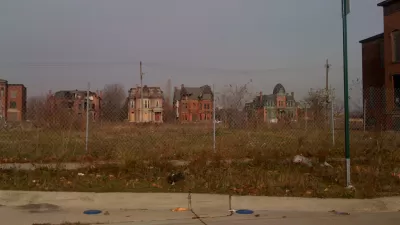Jason Segedy has published a long, brutally frank look at blight and vacant properties, especially at the underappreciated culprit for the woes of so many shrinking cities around the Rust Belt: household decline.

Segedy begins the long article (originally published on Notes from the Underground and later picked up by Rustwire) by asking the question of "why is widespread vacancy and a glut of abandoned property a relatively recent phenomenon, while population loss is not?"
The proliferation of vacancies and blight during the 21st century is the result of demographic trends taking place over 50 years independently from the planning decisions of many cities. In fact, Segedy suggests we "[forget], for a minute, the usual suspects in urban decline, such as “white flight”, larger suburban houses and yards, highway construction, increasing automobile usage, crime, declining schools, etc." and focus on demographic trends like rising divorce rates, rising age of first marriage, rising life expectancy, and declining birth rates, which occurred all at the same time.
Here's how Segedy then sums up the impact of shrinking household: "The role of shrinking household size in urban population loss may be the most under-reported story about urban decline of the entire 20th century."
And it follows: "Urban population decline in the 20th Century, was, in many ways, an unavoidable demographic reality that could only have been mitigated by rezoning and building at even higher densities – a housing trend that would have been running exactly counter to the prevailing market wisdom at the time."
Segedy goes on to provide a detailed and lengthy examination of the housing stock of many Rust Belt cities. Built at low quality between the 1920s and 1960 for industrial workers, the housing stock of cities like Youngstown, Ohio quickly became obsolete and hard to maintain. "All we really know for sure is that there was a lack of demand for most of the product currently on the urban housing market – namely older houses with high front-end renovation costs, significant ongoing maintenance and upkeep costs, and many obsolete features – not enough closets, not enough electrical outlets, small kitchens and bathrooms, no garage, etc.," writes Segedy.
The article concludes with a case study of these dynamics and concepts as applied to the example of Akron, Ohio, where the city tears down an average of 500 houses every year while building an average of ten. Segedy also makes policy remarks obviously directed toward cities like Buffalo and Detroit, which are focusing on things like new stadiums, casinos, or convention centers rather than the only real balm for their decline: new housing.
FULL STORY: What’s in a Number? Confronting Urban Population Decline

Pennsylvania Mall Conversion Bill Passes House
If passed, the bill would promote the adaptive reuse of defunct commercial buildings.

Coming Soon to Ohio: The Largest Agrivoltaic Farm in the US
The ambitious 6,000-acre project will combine an 800-watt solar farm with crop and livestock production.

World's Largest Wildlife Overpass In the Works in Los Angeles County
Caltrans will soon close half of the 101 Freeway in order to continue construction of the Wallis Annenberg Wildlife Crossing near Agoura Hills in Los Angeles County.

California Grid Runs on 100% Renewable Energy for Over 9 Hours
The state’s energy grid was entirely powered by clean energy for some portion of the day on 37 out of the last 45 days.

New Forecasting Tool Aims to Reduce Heat-Related Deaths
Two federal agencies launched a new, easy-to-use, color-coded heat warning system that combines meteorological and medical risk factors.

AI Traffic Management Comes to Dallas-Fort Worth
Several Texas cities are using an AI-powered platform called NoTraffic to help manage traffic signals to increase safety and improve traffic flow.
City of Costa Mesa
Licking County
Barrett Planning Group LLC
HUD's Office of Policy Development and Research
Mpact Transit + Community
HUD's Office of Policy Development and Research
Tufts University, Department of Urban and Environmental Policy & Planning
City of Universal City TX
ULI Northwest Arkansas
Urban Design for Planners 1: Software Tools
This six-course series explores essential urban design concepts using open source software and equips planners with the tools they need to participate fully in the urban design process.
Planning for Universal Design
Learn the tools for implementing Universal Design in planning regulations.


























